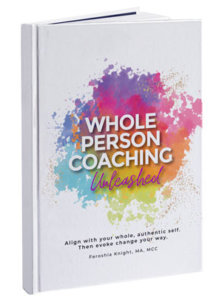Whole Person Coaches champion clients to define and achieve success their way. In doing so, the client is highly motivated to step into their most resourceful and self-innovating mindset. As a Whole Person Coach, success happens when we witness our clients find the clarity, confidence and embodied capacity to be who they truly are, pursue what matters most, and be their very best. With these qualities in place, their potential becomes limitless as does their capacity to create the life they’ve dreamed of living.
But how do you quantify something that personal and exponential to demonstrate a return on investment?
It’s not as complex as you might think.
Coaching services are like anything else: people expect a tangible outcome. But unlike other goods and services that provide immediate and usually fixed takeaways – whether it’s tangible like a home chef meal kit or intangible like career training obtained through a university – the impact of your work as a Whole Person Coach often increases many times over as your clients move through life.
This is one of the most exciting parts of professional coaching. Positive changes in one area of your client’s life promotes positive change in other areas. It can also be one of the hardest to talk about when demonstrating the true value you bring to prospective clients and organizations.
Companies measure collective and individual success through increases in productivity and cost savings. But ROI isn’t just a hot topic for business. Private individuals are increasingly weighing the cost of services against their monthly budgets. Those of us who offer coaching to niche markets must be able to quantify our results if we hope to promote our services genuinely and effectively.
Let’s dive into this topic by first exploring what makes coaching different from other services and the real benefit to tracking your ROI. From there, we’ll look at the varying, holistic methods we use to demonstrate ROI for our current and future clients… Whole Person Coaching style!
What is ROI?
Merriam-Webster defines ROI as:
“Return on investment (ROI) measures the gain or loss generated on an investment relative to the amount of money invested. ROI is usually expressed as a percentage and is typically used for personal financial decisions, to compare a company’s profitability or to compare the efficiency of different investments.”
They go on to include a formula to calculate the percentage of gain or loss: ROI = (Net Profit / Cost of Investment) x 100.
In other words, your client can look at the outcome they receive, assign it a value (monetary or otherwise), compare that to the cost of your services, and multiply it by 100 to get a percentage intended to reflect efficiency.
Is that method fair when applied to coaching services? Is it even accurate? No.
Why coaching services are quantified differently
As Whole Person Coaches, the ROI formula fails to account for the exponential shifts that often happen internally that also affect other areas of the client’s life:
- How satisfied are they overall?
- Are they more open to new possibilities and broader perspectives?
- How do they feel about their self and their whole life: mentally, emotionally, physically, socially and spiritually?
- Do they possess the ability to “self-coach,” drawing upon a more holistic viewpoint toward more accurate responses and decisions for future life experiences?
- Are they confident in being their true, authentic self?
- Have they learned how to figure things out for themselves?
That’s what makes this formula so difficult to apply to clients outside the realm of business. Difficult, but not impossible…
- Did the client lose weight with you as their health & wellness coach?
- Were they able to sustain their weight loss over time?
- Did they see an improvement within their portfolio with you as their financial coach?
- Did they get a new job or a raise with you as their self-esteem coach?
- Were they able to avoid divorce because they discovered how to show up differently in their marriage?
These are just a few examples that provide the opportunity to quantify our work in ways that extend well beyond a rigid formula. But where’s the proof in the proverbial pudding if you’re a pre-engagement coach or a divorce recovery coach?
What about a spiritual or pregnancy coach? Jewish coach? Vegan coach? Passion coach?
In these more personalized instances, your services are just as worth the investment. Yet ROI can be subjective and therefore somewhat more challenging to quantify – challenging, but far from impossible.
Benefits to measuring your ROI for individual coaching
When coach trainees and new grads ask me for advice on becoming a successful coach, the first thing I always tell them is: develop the ability to create reliable results and, equally as important, learn how to market yourself.
Measure and tracking your ROI is an essential part of the equation: Calculating the value you provide is like gold for several key reasons:
- Social Proof. This is the one of the more significant buzzwords you’re likely to find in today’s world of content marketing. In short, the results you’ve achieved with others, backed up by a testimonial or two, have become the cornerstone to most strategic marketing plans. You’ll find social proof on most websites and often right on the homepage.
- Longer Coaching Engagements. The key to a successful sustainable coaching business, is to cultivate long-term client relationships. Often achieved through package deals, knowing you can count on income 3, 6 and even 12 months down the line gives you the confidence that comes with financial stability. By tracking your ROI, you gain talking points to use in your marketing and a measurement of achievement that encourages each client to continue working with you. In essence, you’re saying, ‘Here’s where we started, and here’s where you are today. What do you want to achieve next?’
- Personal and Professional Improvement. Keeping track of the value you provide is just as important for your insight as it is for your clients and prospects. Where do you excel? What needs some work? These metrics reveal what works best for you and how you can develop and improve your coaching capacity in the future. Though it doesn’t take place in a traditional classroom, this central aspect of lifelong learning keeps your services fresh and immediate indefinitely. Which leads us to the last point…
- Job Security. Think about the last show you binge-watched on Netflix. What about a tasty vegan recipe or a yoga class that was challenging but still fun? Did you keep these things to yourself? Chances are you told all your friends and family about the experience. The same is even more true of experiences that lead to profound change in our lives. When a client experiences the exponential shift of Whole Person Coaching, most are more than eager to share their newfound life changes with anyone who will listen. Results breed trust. Trust results in repeat and new business.
Challenges to quantify coaching ROI
Coaching is a human development process. It works holistically to help the coaching client gain more awareness, take new or improved action, be more accountable, and learn. Yet unlike standard forms of education and training, the learning you provide as a Whole Person Coach is not just intellectual. It’s also emotional, somatic, social and spiritual.
Psychologists John D. Mayer, Peter Salovey, Reuven Bar-On, and science journalist Daniel Goleman represent the driving force behind the definition and mapping of emotional and social intelligence (ESI). In the past two decades, they’ve revealed that emotions have a demonstrable impact on our functioning in both work and personal life. Their research allows us to see the limitless potential for learning, growth and success.
However, the highly personal nature of each individual and how they respond to the world simultaneously reveals our limitations – or at the very least our susceptibility to roadblocks. So while two people may have similar goals, one may achieve an outcome well beyond their initial goal. The other may not achieve the same level of success yet find success in a different direction based on their personal background.
Put simply: the impact of our individuality has been scientifically proven. And it makes the task of quantifying your services as a coach somewhat complex and, at the very least, highly personal.
How do you track ROI on coaching?
Given the impact of social and emotional intelligence, there is no magic catch-all formula to track your ROI as a professional coach. But there is a reliable step-by-step process that can help you to create your own way of measuring and evaluating the effectiveness of your coaching over time for yourself and your current and prospective clients.
Create your own ROI assessment…
Step 1: Goal setting. Put the client in charge of defining the goals based on what they truly want to achieve. Unique to each individual, these goals will be either tangible or intangible. For example, one client may want to attract 30 additional long-term clients to their business (tangible). Another may want to feel more confident in having a difficult conversation with their spouse (intangible).
The key at this stage is to put the client in charge of defining what they truly want. This may mean you take extra time to help foster clarity and identify the motivation behind their goals.
Step 2: Establish measurements of success. Though not always clear at the outset, each goal can be quantified or qualified over time. Depending on the type of outcome your client desires, tangible or intangible, the approach is slightly different.
Tangible (a.k.a. objective)
Tangible measurements are relatively straightforward for those who offer coaching services that involve quantities or amounts. Let’s say for example you are a health & wellness coach and a client comes to you for weight loss. Each pound they lose exemplifies the return on their investment. In similar fashion, money coaches tally each dollar their client earns in interest from investments or recovers as they work their way out of debt.
To calculate ROI for tangible coaching outcomes, focus on numerical values:
- Money, time and productivity
- Problem solved (client solves their own problem)
- Opportunity created (client moves forward)
Intangible (a.k.a. subjective)
Even intangible outcomes can be measured with the right tools. For example, if your client’s measurement for success is to feel more confident as a speaker, only they will know whether they feel truly confident. While this can be tracked with a journal recording feelings and their intensity, there are also more concrete ways to evaluate success – more visible ways for both the client and coach that is!
For example, behavioral evidence could include the fact that they’ve taken initiative to apply for more speaking gigs. Perhaps their posture looks more confident on stage and their mannerisms are more open and engaging. They might speak in a voice that sounds more confident or joke around more freely. These intangibles can be measured through self-assessment and a couple other different ways we’ll look at in a moment.
To calculate ROI for intangible coaching outcomes, focus on “whole person” development:
- Your client’s newfound clarity (i.e. communication style is more fluid; life purpose or what truly matters has been defined); focus (client sustainably remains on track and is now more effective at accomplishing tasks); broader or deeper understanding (client has a more holistic perspective and draws upon multiple sources of information).
- New capacity for emotional management is central here. For example, client now recognizes when they are emotionally affected and takes care of themselves versus reacting to others; client now stays calm and effectively manages stress even during highly charged conversations. Client sleeps better at night.
- Client feels stronger and goes on longer walks without huffing and puffing; client sleeps more than 5 hours a night; client goes “X” days without a cigarette or alcoholic drink; client loses “X” number of pounds; client shifts dietary preferences (water versus soda, fruit versus candy, home cooking versus fast food).
- Client is more comfortable being open and honest about their needs, demonstrated by their willingness to ask for what they want; client is now more comfortable networking or in other socially demanding settings; not as fatigued by being in large groups of people.
- Client discovers their true purpose in life; aligns their path or goals with spiritual beliefs. Taps into deeper inner knowing and finds a spiritual path that brings them peace and serenity. Client has found a community and takes an active part in a leadership role.
The takeaway here is that every situation offers the opportunity to quantify results – whether you track metrics in the form of hard data or create evidence derived through behavioral markers.
Step 3: Track your client’s progress. You have several tools and opportunities to not just gather data but also highlight and champion the client as they move closer to their end goals. These include:
- Coaching Plans
- Self-Assessments
- 360-Degree Feedback
- Individual Sessions
Coaching Plans. A standard coaching plan is like a big diary of goals, learnings and successes. As a Whole Person Coach, your coaching plan is far more extensive. It covers everything from your client’s career, business and identity to health, enjoyment, creativity, spirituality and even relationships. This is true whether their end goals pertain to creating life balance, achieving personal fulfillment, life transitions, or working toward some aspect of success.
KEY POINT: when you possess the capacity to view your client as whole, each aspect of their life offers the potential for demonstrating ROI.
Self-Assessments. These are one of my favorite tools because they allow the coaching client to evaluate your success with a “grade,” so to speak. It also offers them the opportunity to look inward and gauge their progress, owning it as opposed to simply being told they’re doing better.
Often viewed on a scale from 1 to 10, self-assessments provide structure and are commonly used at the beginning of each coaching session based on what the client wants to be coached on. They also take in the full landscape of the process, allowing you to look at how the client rated their area of focus when you began working together and how they’re feeling about that same issue weeks, months or years down the line.
For example, if you offer relationship coaching, you might ask your client at the outset to think about how much trust they place in their partner or themselves (if that’s what they’re seeking clarity on), with 1 being none and 10 being complete. At the close of your session, you pose the question again. Did the number rise? Why? What changed? And more specifically, what did the coach do during the session that contributed toward the client’s ability to shift?
360-Degree Feedback. These assessments offer anonymous feedback obtained through multiple people, from friends and family to colleagues and co-workers. Skills and topics under consideration are frequently given a rating scale (i.e. 1-10) while encouraging respondents to offer detailed, written comments as well.
People often notice much more in others and their reflections can be valuable in assessing behavioral changes. These kinds of assessments can offer a helpful starting point for a client interested in setting a new beginning and/or concluding an evaluation period. But it can also be harmful if the “information” shared isn’t presented effectively by the coach or assessor. Remember not everyone has a skillful way of communicating what they observe about others, as a coach might!
Individual Sessions. As a professional coach, you track the effectiveness of the coaching and the client’s progress related to their session goals and deliverables within every coaching session. These metrics are set up near the beginning of the conversation and define the purpose of the session. They also inform the coach as to how they can best assist the client to use their time and the coaching process wisely.
Session metrics are often fixed on a single session, but the data can be recorded into a coaching plan then repurposed (anonymously) to relay the ROI you provide.
While it may seem like it’s enough to simply “know” what the client wants to achieve as a result of working with you, too often coaches overlook the importance of the coaching plan and the individual session agreements. Tracking your session progress, as opposed to just “going with the flow,” gives you the opportunity to conduct continuous check-ins. It’s a practice designed to not only keep you focused, it’s also critical to building a case for ROI.
Tools for tracking coaching ROI
Proving your return on investment (ROI) is a necessary part of operating as a professional coach. Not only does ROI reinforce the deliverables you’ve promised each client, it also establishes the core of your marketing efforts by “proving” you have done for others what you’re aiming to do for your prospects.
As a Whole Person coach, ROI should be determined first by your individual clients then tracked and measured by you in the most objective, evidence-based way. It’s impossible to not be somewhat subjective. But that should never stop you from demonstrating progress in an authentic, honest way.
There are numerous software applications out there that can help, including CoachAccountable, Nudge Coach, CoachVantage and Coaching Loft. These platforms can help track the metrics we’ve discussed. Just be sure you’re tracking the right metrics for the client (what truly matters to them) as opposed to simply overlaying someone else’s idea of what success looks like to check off boxes in a software platform.






Great ideas for measuring ROI and tracking it. Done well and communicated often, positive ROI can attract others with little effort.